DOC NYC Film Festival Nov. 8-15

Senior Critic Kurt Brokaw Explores America’s Largest Doc Festival
Every documentary filmmaker’s heart has to beat a little faster looking at the 300 films and panels coming into the 9th annual DOC NYC. Two features taking victory laps, Won’t You Be My Neighbor? and RBG, have already earned domestic grosses of $22 and $14 million dollars. These are unprecedented earnings for a pair of biopics that draw heavily on archival materials. (Co-directors Julie Cohen and Betsy West of the Ruth Bader Ginsburg work will be giving a case study on researching historical clips at 2:15pm, Wed.Nov. 14, while the Mr. Rogers’ director, Morgan Neville, will join other portrait directors for a panel discussion at 10:30am on Fri.Nov.9.)
This mammoth fest, with a 4-color program weighing in at 120 pages, has neatly divided its scores of feature attractions—47% of which are directed or co-directed by women—into nearly two dozen themed categories plus ten different shorts programs. Everything including 41 world premieres rolls out over one week onto 16 Manhattan screens at the IFC Center, the SVA theater, and Cinepolis Chelsea. Like the annual New York Film Festival and Tribeca Film Festival, there’s no way you can experience it all. So this viewer, whose days are darker than your nights, offers a few select nuggets for your consideration:
Asimov & Le Guin: The Futurists
The Truth About Killer Robots; Maxim Pozdorovkin; USA, 2018; 82 min.
Isaac Asimov, arguably the preeminent male science-fiction writer of the 20th century, is explaining his story, “Runaround,” in what looks like a grainy, black-and-white kinescope clip from the 50s. The tale appeared much earlier, in a 1942 issue of the pulp magazine Astounding (pictured), when Asimov was a penny-a-word pulpster. It was there he posited his Three Laws of Robotics: (1) “A robot may not injure a human being, or, through inaction, allow a human being to come to harm. (2) A robot must obey the orders given it by human beings, except when such orders would conflict with the First Law. (3) A robot must protect its own existence as long as such protection doesn’t conflict with the First and Second Laws.”
Pozdorovkin’s documentary lets Asimov deliver these even-handed and owner-friendly projections, then unleashes a flurry of modern-day vignettes that largely zaps them all. What’s creepy scary— what makes this an increasingly absorbing yet bewildering viewing experience— isn’t the use of artificial intelligence by police, military and marketers that still have the ability to surprise and shock. It’s how humanoid machines are inching, insinuating and cozying their way into the social fabric of lives worldwide.

One example: If the notion of a shy young male factory worker watching movies with and sleeping alongside a life-size Kodomoroid reminds you of some nightmare graphic novel, the director shows it happening in an internet ‘dream village’ in East China’s Hangzhou metropolis. Leggy and fashion-savvy, this attractive original has several dozen actuators that mimic her facial reactions, and a variety of intimate speech tonalities. And she’s not some animatronic mascot parked on the factory floor, she’s his legal wife. Yipes.
The Truth About Killer Robots initially has enough violent episodes to justify its juicy title that draws you in. The Russian-born Pozdorovin, a New Yorker with quirky credentials like Our New President and Pussy Riot: A Punk Prayer, assembles vivid mini-histories with machine-like precision. One relates a 21-year-old German Volkswagen factory worker—perhaps admitted by a faulty circuit into a no-humans zone—pushed into a wall by a robot’s arm and crushed. Another finds a Florida man in a self-driving Tesla who may have been viewing a Harry Potter movie at 74 mph and didn’t see a semi-trailer turning into his path. A third recounts the Dallas SWAT team that took out a barricaded hotel shooter by maneuvering its bomb squad robot armed with an explosive device down to the killer’s room. These tragic incidents play like the front page fatalities we’ve borne witness to, far too often.
What we’re not accustomed to is watching the female CEO of a California pizza delivery restaurant proudly displaying how three robots essentially create, cook and box her product, then dolefully eyeing the worker who still hand-tosses the pizza into the air, noting “this step isn’t quite optimized yet.” We’re also not used to seeing a legal startup known professionally as Robot, Robot and Huang, in which the first two senior partners are an Apollo Cluster with a specialty in data compilation and “Daria,” an XR1029 that’s a whiz in intellectual property.
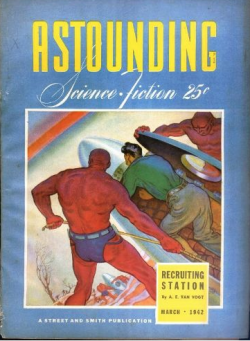
It gets weirder: Hiroshi Ishiguro is a roboticist who’s aging faster than his manufactured humanoid…so Mr. Ishiguro is having plastic surgery to age down to his unchanging other self. And how about about a warm welcome for the Henn-Na Hotel in downtown Nagasaki, Japan. The entire main staff, from the check-in desk to the pianist in the cocktail bar, are robots. Granted they have a limited understanding of customer requests, as one couple discovers when they ask for an extra pillow that stumps their hosts.
You can’t make this stuff up, like Asimov, Heinlein, Clarke, Bradbury, Dick, Hubbard and their male cohorts innocently did in the 40s. (Oh, and let’s not forget their female counterparts like Catherine Moore, Margaret St. Clair, Andre Norton, Judith Merrill and especially Leigh Brackett, who stayed a superior science fiction pulp writer while turning out 30 years of screenplays from The Big Sleep to The Empire Strikes Back. Brackett even occasionally collaborated with, and possibly romanced Ray Bradbury.)
The Truth About Killer Robots shows Sun.Nov.11 at 9:30pm at the IFC Center. It premiers on HBO on Nov. 26.
Worlds of Ursula K. Le Guin; Arwen Curry; USA, 2018; 68 min.
Ray Bradbury was fond of defining science fiction as holding on to the edge of a cliff, and science fantasy as shoving you off, at which point you discover you can fly “by inventing wings on your way down.” It’s a big difference, one that’s helpful to remember while immersing yourself in Arwen Curry’s robust and immaculately concise biopic of the late novelist, who died earlier this year at 89 at her Portland, Oregon home. Le Guin wrote 23 novels plus stories, poetry, children’s fiction and non-fiction. Her Earthsea series and Hainish cycle novels have been translated into 40 languages.

Curry’s investigation benefits from having Le Guin telling much of her life on-camera. Educated at Radcliffe and Columbia University in the late 40s, she was the daughter of Alfred Kroeber, a leading anthropologist at the University of California at Berkeley. (Le Guin took the “K” in Kroeber as her middle initial.) “Our house was always full of scientists and Indians, so I guess I was raised with cultural relativism. I never thought fantasy had to be at odds with science,” she’s said.
We see Le Guin joining post-war women in California, marrying a French history professor and raising three children while trying her hand as a writing mother. She manages to sell half a dozen stories involving time travel, world-building and mixed-race populations to pulp magazines and digests like Amazing and Fantastic. But the rejection letters from mainstream hardcover publishers pile up, describing her work as “essentially plotless (with) very lengthy intellectual discussions reflecting the politics of the period.”
Samuel Delany, then a fledgling African-American sci-fi writer at Ace Books, introduces her to editor Don Wollheim. Ace had pioneered an Ace Doubles line of back-to-back paperback originals, often partnering a slightly marginalized writer with a complete unknown, and boldly charging 35 cents instead of the industry’s standard price of a quarter. Wollheim had done well launching Philip K. Dick’s originals in the 50s, and both Dick and Le Guin had attended Berkley High School together though they didn’t know each other. Serendipity: Ace debuts her Rocannon’s World in 1966.
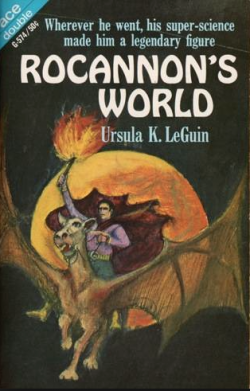
Le Guin had no interest in traditional nuts-and-bolts science fiction “with all those green monsters attacking girls with metal bras.” But to some old-school pulp magazine collectors, her first novels are sophisticated variations on an action/adventure genre known as sword-and-sorcery—mostly armored hunks who took on giants, dragons and dinosaurs. Robert E. Howard’s Conan and Lester Dent’s Doc Savage were the superhero pulp prototypes. Le Guin was surely thinking, why not a younger, smarter, stronger woman?
(Curry’s film doesn’t mention this, but Le Guin was probably familiar with some of the 39 Doc Savage pulp novels featuring Doc’s 18-year-old cousin Pat, one of the first Women of Wonder—a savvy pilot with bronze skin and hair as well as golden eyes, who carried a Colt Frontier Six Shooter and grew up to manage a string of Park Avenue beauty salons.)
In 1968, Le Guin makes her first entry into the world of young adult fiction and magical storytelling in utopian settings. At this point in the narrative—which was filmed over an eight year period and started when Curry was a graduate student in journalism— the producer/director introduces the gorgeous animation of Em Cooper and Molly Schwartz. Their visual interpretations and Le Guin’s voice-over narration begin to power the viewer through the essences of key Le Guin works. Author Neil Gaiman confirms what may gradually dawn on you if you’re new to Le Guin’s work, that “Harry Potter could not have existed without Le Guin’s A Wizard of Earthsea in 1968.” In that book, a young wizard must exercise great care and responsibility to stabilize the equilibrium of the universe.
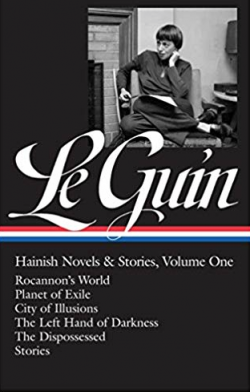
The Tombs of Atuan follows with its colony of women and a young female protagonist in 1971. The Left Hand of Darkness posits gender equality on the frozen planet Winter. Awards began to follow; Le Guin wins both Nubula and Hugo awards from the speculative fiction experts, as well as the National Book Award in the childrens’ book category for The Farthest Shore. The Library of Congress designates her a Living Legend in 2000.
Radically experimental, Le Guin roams through a myriad of genres, exploring flawed and ambiguous utopias, non-violent anarchy, a traditional male hero stripped of all power, a mistreated child alone in the most wonderful of all cities, even global warming in Portland where it begins to rain and doesn’t stop. In Le Guin’s worlds, “Home is not a place at all. Home is imaginary. Home, imagined, comes to be.”
Curry’s tightly fashioned documentary has the unmistakable goal of eulogizing Le Guin as a major figure of American letters. Her biographer Julie Phillips, a retinue of articulate female authors and editors in the field, and bold-face names like Margaret Atwood and Michael Chabon carry her legend forward. Le Guin’s remarks upon receiving the 2014 National Book Foundation’s lifetime achievement award are as plain-spoken as her comments to an adoring hometown audience at Powell’s Books in downtown Portland. Like Asimov, she was a futurist before her time.
Worlds of Ursula K. Le Guin shows Sat.Nov.10 at 11:45am at the SVA theaters.
A Sharper Sword; Olivier Bernier; USA, 2018; 10 min.
East 213th Street and Holland Avenue—Every NYC doc maker knows life in the Bronx is no cakewalk. 28-year-old Daryl Homer grew up here, being raised by a single mom on Gun Hill Road. Homer has grown into a champion fencer, winning multiple bronze medals in international competitions, as well as the silver medal at the 2016 Summer Olympics—the first American to win individual silver in men’s sabre in 112 years.
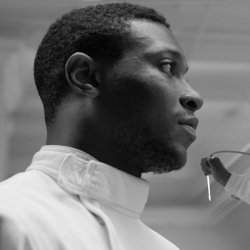
We watch and listen to Homer walking the streets, jogging, riding the subway, and teaching the basics of lunge, parry and riposte to inner-city youth who come to Peter Westbrook’s Fencers Club on West 28th Street. Westbrook, 66, is Homer’s fencing mentor and head of the Peter Westbrook Foundation. A six-time Olympian, he’s also the first African American to win a national gold title. Like Homer, Westbrook grew up poor, the son of an African-American father and a Japanese mother in Newark.
This masterful short, shot in widescreen black-and-white not unlike Alfonso Cuaron’s tonal, muted gray imagery in Roma, is briskly narrated by both men who offer profound life lessons. Their mission is clearly to change global perceptions about fencing. Bernier directed, produced, edited and was co-DP, and you can add A Sharper Sword right now to your Oscar list for best short of 2018.
“Make no bones about it, fencing is a white, aristocratic, European sport,” states Westbrook, a wiry precisionist in both thought and movement. “But the vicissitudes and ups-and-downs of fencing prepare you for the vicissitudes and ups-and-downs of life. You have to dream about, your whole life, this particular sport, and immerse yourself—your mind, your body, your spirit, your soul.”
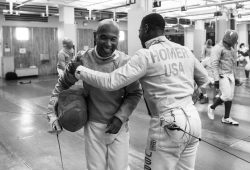
Westbrook has special praise for Homer, who he watches instructing an eager, on-point class of boys and girls. “I am impressed, the heights that he is achieving in fencing, and I expect to see more greatness come out of him.” The two men are a joy to watch as they instill skills and confidence in their young charges, but it’s Westbrook who has the longer core belief that fencing “can uplift one another, know one another, encourage one another, even love one another. And by coming together—different backgrounds, different colors, different races—we contribute to the greatness of all mankind.”
Homer plans to pursue gold at the 2020 summer games in Tokyo.
A Sharper Sword shows as part of the Big Apple Shorts Program Sat.Nov.10 at 10:15am at the IFC theaters.
Afterward; Ofra Bloch; USA, 2018; 95 min.
Even the most experienced doc directors can stumble when they direct themselves as both interviewer and narrator/subject. They end up hogging far more screen time than they earn, or they become like talk-show hosts, endlessly smiling and nodding agreement with their subject’s every opinion.
Ofra Bloch avoids these pitfalls. She’s a psychoanalyst who was born in Jerusalem, served in the Israeli military, and married a Holocaust survivor. She learned documentary filmmaking through a decade of creating shorts, with the goal of tackling a feature doc she’d co-write and direct (her Afterward co-writer is Michael Palmer), and now she has—Bloch’s the perfect shadow director who’s almost always present but never in the way. In the Q&As that fill this well-paced, engrossing investigation, she mostly keeps still and rarely laughs. She’s directing herself—editing herself—to be a serious, respectful listener. This is so smart, because the viewer instinctively follows suit.

We immediately trust this stout, sometimes severe woman as she becomes our trustworthy guide through a thicket of painful, traumatic interviews. They’re set in corners of troubled cities and neighborhoods—Hebron, Berlin, Kassel, Haifa, Al-Nahr, the Bavarian quarter, Wadi Silwan in East Jerusalem. Though she’s apprehensive and at times frightened, Bloch strides confidently onto every urban and rural situation (some bristle with soldiers armed to the teeth), usually dressed in flowing white from head to toe. She’s a bold but self-possessed presence, and she never threatens a soul. Her first question is often “Will you talk with me in English or Hebrew?”
Bloch’s mission is “trying to find the past in the present lives” of survivors. She’s interviewing the sons and daughters of both victims and perpetrators of some of history’s most terrible global crimes: the Holocaust, Palestine’s 1948 Nakba (“day of catastrophe,” when upwards of a million people were exiled from their homes), the Israel/Gaza war of 2014. She’s written herself a thankless task, but we accept it as a legitimate piece of the eternal Jewish mission inherent in the vow “never again.”
Bloch’s own childhood memories include helping her uncle, a camp survivor who had no refrigerator, carry home blocks of ice with tongs while she listens to his tales of how he outfoxed Nazi commandants—until she learns most of his family perished around him. We view the walls of her present home, filled today with war memorabilia—pieces of a German bunker, a photo of a Russian soldier carrying a statue head of Hitler, the yellow Jewish star sewn on the sleeves of the imprisoned. Bloch feels guilt in her initial “afterward” about not wanting to know how Palestinians feel about their “afterward,” which is in part why she chose to make this her first feature.
And so we journey with this committed filmmaker as she interviews the descendants of Germans and Palestinians, discovering how they’ve handled their catastrophes with families, friends and associates, even Jewish acquaintances. It’s a unique concept. Many are ashamed by how rarely the Holocaust is even spoken of. Palestinians are bitter about Israelis always portraying themselves as victims. No one seems happy with the occupation of cities like Hebron—Jewish tears are equal to Palestinian tears, admits a fellow female Palestinian psychiatrist in Ramallah, but the causes will never be equal.
That psychiatrist, who treats women and children trapped in the Occupation, also talks at length about how Palestinians who die by anything other than natural means—like in a firefight with authorities—cannot be buried normally but must be smuggled away to an unknown resting place. Bloch herself dreams of SS officers smashing her glasses as she cross-cuts WWII footage with Eichmann’s seizure and people glued to radio broadcasts of his trial. You can sense this is a harrowing doc and more than once you’ll cling to Bloch for psychic reassurance.

The director wants to learn if forgiveness is possible on any of these killing grounds, from relatives of the dead to children of those who perpetrated the murders. Forgiveness is not in abundance. Bloch becomes aware the cumulative weight of the Holocaust silences many Palestinian protests of the occupation. A destroyed Holocaust memorial building is mounted upside down in the ground by its artist creator, to mark a people forever lost from Kassel. A professor recalls his father, a scarred German officer who died decades ago, screaming ‘duty, obedience, subordination’ at his son and granddaughter. Bloch views a street sign in the Bavarian quarter that “Jews are not allowed to keep dogs” next to a drawing of a cat. Some of Afterward can be genuinely disorienting.
Bloch feels confusion being with people she’s regarded as oppressors but also empathy with those who feel guilt about past deeds. A young Palestinian war photographer tries to make sense of the deaths he’s recorded with his camera—what he’s torn up by is the notion of Israeli Prime Minister Benjamin Netanyahu having breakfast with his own children. Palestinians displaced from their neighborhood enact a boycott, divestment and sanctions (BDS) against Israel, which US ambassador Nikki Haley condemns as anti-Semitic at the United Nations.
The director returns at last to her childhood home in Jerusalem. She looks out through what was once her bedroom window at what used to be an almond tree that would blossom every spring. And of course the tree is gone. Bloch reluctantly accepts it will no longer come back—we suspect perhaps her own healing has begun. It took her new life as a doc director, not a psychoanalyst, to create that epiphany, but maybe that’s the power of movies.
Afterward shows Mon.Nov.12 at 7:15pm at Cinepolis Chelsea.
Dennis & Lois / The Sheriff: The Music Scene
Dennis and Lois; Chris Cassidy ; USA, 2018; 85 min.
The heart and soul of New York’s uncharted music scene for nearly half a century has been the world of characters that inhabit it, onstage and off. Moondog, Wavy Gravy, Penny Lane, The Sheriff…the list is unending. No one in the audience goes back further—and deserves their own 85 minutes of glory—more than Dennis Anderson and Lois Kahlert.
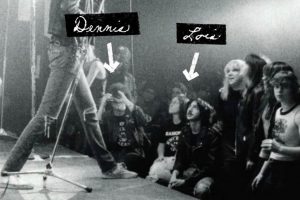
Look at the two of them, barely out of their teens at a Ramones show at CBGBs in 1976. They’re already in love with the music and falling in love with each other. That band, Henry Rollins once said, “was a mineral, virtually formed. To mess with it, you’re immediately meddling with forces far greater than you.” In Chris Cassidy’s thrilling assembly of a punk era—no, wait, make that a punk lifetime—Dennis and Lois vowed to become its guardian angels forever.
“The Ramones, Undertones, Mekons, El Vez, Happy Mondays, Doves, Elbow, Badly Drawn Boy, Frank Sidebottom—half these bands slept on your sofa or floor at one time,” recalls Andy Rourke of The Smiths. The Ramones’ graphic designer, Arturo Vega, knew they were hardcore fans when the Flatbush girl and the Hoboken guy followed the band to a pizzeria in Pittsburgh and offered to run the merchandise table. Dennis affirms fans’ emotions at live shows like Nick Cave, Oasis, Joy Division,The Human Order, Hold Steady, the Vaccines, Black Rebel Motorcycle Club, and New Order: “No one knows what’s going to happen. That’s what we live for. And there’s not too many people we haven’t seen.”
Their Brooklyn home has become a repository—more like a museum—of their travels through America and much of England following the music through 10,000 shows. Significantly, the couple embraced the British explosion—not just Manchester shows and whole tours but even rehearsals— with the same passion and fervor as American bands. They have over 5,000 U.S. and U.K. albums. There are as many issues of NME (New Music Express) piled up as The Village Voice. They’re compulsive collectors of T-shirts, ticket stubs, toys, every kind of music memorabilia. (Whole rooms are dedicated to other pop culture icons from Batman to Dr. Who.) The fan dimension has grown into lifelong friendships with surviving artisans.
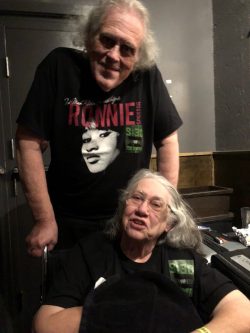
Jimi Goodwin of the Doves remembers meeting Joey Ramone as a young boy “because the T-shirt guy thought it would be funny to have this little kid meeting this giant.” “We became part of their collection,” adds Sally Timms of The Mekons. “They replaced their Ramones license plate which was always being stolen with a Mekons plate which has never been stolen.” In a blizzard in Wyoming, Lois summarizes the feelings of many musicians when she says “everyone should have the blessing of seeing their country with a band that they love.”
Amazingly, Lois received a 25-year recognition plaque from the corporation she toiled at as head of print production. (She took a lot of leaves of absence.) Happy Mondays wrote a song about them. Damon Gough thinks Dennis and Lois should probably also sign his posters that they sell, making them more collectible.
In what appears a time of recognition for these aging seniors that will never end, Lois begins to suffer the effects of a long-ago knee injury in a mosh pit. Through the years it may have migrated into back pain, and a late diagnosis of multiple sclerosis turns her cane support into a wheel chair. Dennis and Lois’ worldwide fans and bands begin to give back. and Dennis and Lois is exhibit A. Manchester becomes their spiritual home, and Dennis continues to get Lois properly situated at shows to watch her fave bands. John Grant serenades her with a whole symphony orchestra and tells her “I wish my parents were more like you.”
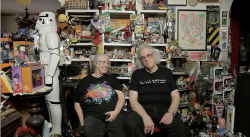
Cassidy’s assembly and direction, covering a five-year shooting period, is thoughtfully fluid. He doesn’t fast-cut and you don’t get jerked away from moments you’d like to linger on. A special shout-out to Richard Borge for nifty animation snippets, which drop in like mischievous grace notes when you least expect them. This rock doc’s a keeper.
Dennis and Lois shows Wed.Nov.14 at 3:00pm at IFC, and Thu.Nov.15 at 9:45pm at SVA.
The Sheriff of Goodtimes; Brad Hinkle; USA, 2018; 13 min.
Years before Dennis and Lois were making their nightly forages to CBGBs, Robert Seidenberg was playing bluegrass music in downtown Manhattan. He defines it as “maybe a hundred songs between the Stanley Brothers and Flatt and Scruggs,” joined to roots’ jams usually led by a fiddler and most anybody who’s taken the time to learn the chords and songs. The locale for this pleasantly low-key jaunt into traditional songs (as well as items by Carl Perkins and Townes Van Zandt) is Zinc, near West 3rd and Sullivan. “There’s been bluegrass in New York since there’s been Kentucky bluegrass,” confides Seidenberg.

Seidenberg—or “Sheriff Bob” as he began calling himself 20 years ago when he pinned a badge onto his wardrobe of neatly tailored leather vests—began singing in the seminal Gaslight room around 1960, playing background to poet Hugh Romney (later Wavy Gravy of Woodstock fame) and jamming with Bob Dylan at the nearby Kettle of Fish. Playing a wood body, lap-style Dobro, Bob (who’s never far from his wife of 58 years, Susan), leads public jams in places like Mona’s, Banjo Jim’s, the Grisly Pear, Lowlands Bar, Paddy Reilly’s Music Bar, and Sunny’s Bar in Red Hook, as well as his Washington Square Park back yard.
His buddy in the park since 1958 has been banjo player Roger Sprung, who started busking for chump change in the late 40s and offers his CDs with Doc Watkins for $15. Also on board for the past 16 years is his “Deputy” and associate producer, Kathryn Minoque, who handles vocals and guitar. “There’s so much incredible music to play, as well as ‘who’s going to roll into town this week?’”says Abby Hollander, who’s on bass and vocals in the Sheriff’s jams. Adds harmonica player Trip Henderson: “Bob continues this tradition that goes back to the 50s in Greenwich Village with folk and bluegrass. If you’ve got the long view, it hasn’t really changed that much, the Village has always been a place for southern vernacular music.”

Direction, editing and co-cinematographer chores are handled with efficiency and dispatch by Hinkle, who will probably offer you assurance you won’t have to wear ear plugs at a Sheriff Bob jam.
The Sheriff of Goodtimes shows as part of The Big Apple shorts program Sat.Nov. 10 at 10:15am at IFC.
What She Said: The Art of Pauline Kael; Rob Garver; USA, 2018; 95 min.
Kael (1919-2001) was a major force in a pre-internet world in which movies, movie criticism, and movie critics, all meant more. She was a Polish Jewish immigrant who wrote by hand, in pencil, starting out reading radio reviews on KPFA-FM in San Francisco and programming a local art cinema. When she retired from The New Yorker in 1991, many felt she was the most influential film critic of her generation. In her final conversations with Francis Davis (Afterglow, Da Capo Press, 2002), she staked out her legacy: “I didn’t want to write academic English in an attempt to elevate movies, because I think that actually lowers them. It denies them what makes them distinctive.”
Rob Garver, bless his young documentarian heart, has assembled an even-handed, bracing biopic of Kael’s life from archives, letters (voiced by Sarah Jessica Parker, a splendid choice), demonstrative clips and 43 interviews, rife with all the industry veterans—David O. Russell, Greil Marcus, Stephanie Zacharek, Paul Schrader, Molly Haskell—you’d hope would weigh in on Kael. Her daughter Gina, who did all her mother’s typing and driving until she was 30, gives generous recollections.
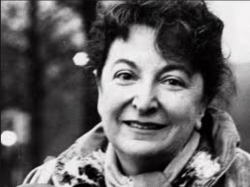
There are no bold-face executive producers supporting Garver’s work, and his Kickstarter effort in 2015 didn’t come anywhere near reaching its goal. This has got to be one of DOC NYC’s biggest labors-of-love, because who’d come watch a doc on a dead movie critic besides the 60 or 70 American reviewers who actually still eek out a living seeing movies full-time?
Yet Garver has nailed most of the influences that have kept Kael’s 13 books of film criticism (including the 1290-page For Keeps, Dutton, 1994) freshly relevant. What she said in print is what we’d wait for and clip from New Yorkers week after week, decade after decade, long after the networks’ talking head’s latest reviews were forgotten and the daily newspapers with their opening day write-ups had been tossed.
Kael grew up in the silent era and chose Chaplin’s Limelight as her first movie to review. She was a single working mom in the 40s, and felt a kinship with Hollywood’s sassiest, classiest comediennes. Her language was salty, sometimes lurid. The two pictures she’s most noted for championing—Penn’s Bonnie and Clyde (1967) and Bertolucci’s Last Tango In Paris (1972)—turned the page on screen violence and sex She embraced mavericks like Russell and Robert Altman, and the directors she said she felt closest to were Sam Peckinpah and Jean Renoir.
Her reviews upset one A-list director after another: David Lean was so distraught by her pan of Ryan’s Daughter, he stopped directing feature films for 14 years. After reading her attack on Blade Runner, Ridley Scott fumed “three pages of slaughter, I was so offended, I would never read any more press.” George Roy Hill wrote her a letter after her devastating review of Butch Cassidy and the Sundance Kid that started “Listen, you miserable bitch, you’ve got every right in the world to air your likes and dislikes, but you got no goddam right at all to fake, at my expense, a phony technical knowledge you simply don’t have.”
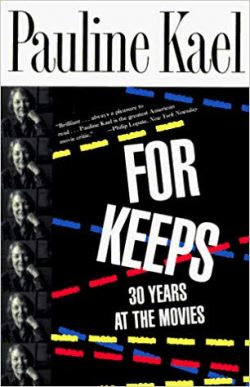
After 11,000 reviews, she was understandably exhausted, and she closed her Afterglow interview with Davis lamenting “a movie industry in decay, and the decay gets worse and worse.” She also didn’t have much use for “second rate reviewers who are just trying to get through the day, scared of their editors, scared of their readers, scared of the movie companies, and are never good enough to conquer their fears.”
The film touches on her unique adoration by a tiny, loyal band of film aesthetes who were dubbed “Paulettes.” At least four of them—Michael Sragow, David Edelstein, Carrie Rickey, and James Wolcot—pay their tributes here. It seems to have been a singular, once-in-a-lifetime kind of recognition for a movie critic. Kael’s past and present female contemporaries—Rickey, Zacharek, Manohla Dargis, Renata Adler, Penelope Gilliatt, Judith Crist, Janet Maslin, Lisa Schwarzbaum—have all enjoyed substantial readerships but none at Kael’s level of cult adulation. (Susan Sontag probably came closest.) Today, on an uncomfortably level online playing field in which anyone can knock out movie reviews—and thousands do—we haven’t seen any societies of Dargisites, Scotties or Zacharettes blooming. More’s the pity.
What She Said: The Art of Pauline Kael shows Sun.Nov.11 at 1:45pm at SVA.
In The Absence; Yi Seung-Jun; USA, 2018; 26 min.
Most of our collective experience of disasters at sea comes from our movie journeys: Titanic, The Perfect Storm, All at Sea, The Last Voyage, The Poseidon Adventure…all the way back to chestnuts like Lifeboat, The Sea Wolf and The Sea Shall Not Have Them. Our memory bank in the safety of darkened theaters tells us we’ve seen it all: confusion, misguided or insufficient or too late rescue attempts, panic, terror, last moments. We haven’t seen anything.
Veteran South Korean director Yi Seung-Jun (Planet of Snail), working with Oscar winner Laura Poitras and her co-exec producer Charlotte Cook, has built a truly terrifying account of the 2014 capsizing and sinking of the Sewol, an arcane and overloaded transport ship carrying 476 passengers (including 324 students on a school trip), an interim captain and crew of 33, and over 2000 tons of cargo including several hundred cars. The Sewol was headed from Incheon Port to Jeju Island, a 13-hour journey it had safely made hundreds of times. You may remember these news photos of this gargantuan hulk lying helpless on its side, and asking yourself How could this have happened?

As the ship entered a foggy Maenggol Channel, a third mate and helmsman changed the wheel from autopilot to manual. The Sewol began to list to port. A corrective order, interpreted incorrectly, turned it further to port. A sudden turn back to starboard caused dozens of cars below to snap their holding chains and shift position, tilting the ship 20 degrees into the sea. At this point the wheel stopped responding altogether. The side door of the cargo loading bay began to collapse. The engines shut off. Water began flooding the passenger compartments. The Sewol began to sink—
—Which is where Yi’s mesmerizing 26-minute documentary begins, with a minute-by-minute playback of signals from the bridge and passenger calls for help…a security camera showing a dislodged car knocking a hole in the hull…cell-phone footage revealing some students panicking while others remain calm in the cabins where they’ve been told to stay…a lone patrol boat arriving at the scene and picking up the captain and other officers who’ve abandoned ship, as half the passengers including students below decks begin to don life jackets but wait for someone, anyone, to lead them to safety…helicopters picking up a few people in rescue baskets directly off the tilting deck…dash cams showing the unmoored cars now underwater, floating freely…a rescuer onboard trying desperately to extend a fire hose into a flooded corridor to reach the trapped… nearby fishing boats and a Coast Guard vessel retreating as the entire gigantic bow begins slipping under the waves.
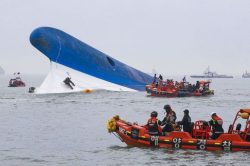
It’s like watching Titanic, except this is real life, not illusion. Onboard, with most life jackets still locked in cabinets, 291 will perish. (The President’s office keeps telephoning, ordering no casualties and insisting no one be missing throughout the ship.) This all actually happened in less than two and one half hours, but here through brilliant, quicksilver editing, you live it in just 15 minutes.
The next day, part of the Sewol’s hull resurfaces and civilian divers join the Coast Guard in pumping air into the exposed surface, as President Park Geun-Hye looks on. The government’s diving equipment is declared “decrepit”and fails. Civilian divers take over for the next three months, recovering several dozen bodies from 40-metre deep waters. We know nearly all were students, because we’re shown their sneakers through underwater lenses, neatly stacked together on the floors of their rooms. The government halts all civilian operations, and a year of civilian protests, led by grieving parents, follows. Hearings are held. The Coast Guard commissioner testifies he “could only stomp my feet out of frustration.”
The disgraced caption claims he “can’t remember” whether there was a plan before or during the emergency to save the passengers. President Park is expelled from office. After her removal, the salvage of the raised Sewol begins, three years after its sinking, Remains and more than 100 mobile phones are recovered. “This is a haunting pain and a big burden on my heart,” confesses one civilian diver. A widow mourning the suicide of her traumatized diver husband tells us “the untruth has sunk, and the truth has been salvaged.”
We’ve learned one fact of enduring docs is how well they speak truth to power. That’s an indelible asset DOC NYC has been celebrating in big and small ways for nearly a decade. Frederick Wiseman puts it this way:
“Documentaries are biased, prejudiced, condensed, compressed…but fair.”
In The Absence shows as part of the Legacy shorts series Fri.Nov.9 at 9:55pm in Cinepolis Chelsea.
This concludes critics choices. Watch for Brokaw’s picks in the 28th New York Jewish Film Festival, January 9-22.
Regions: New York City
